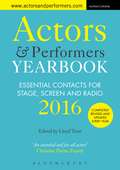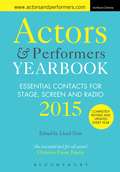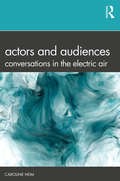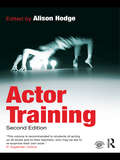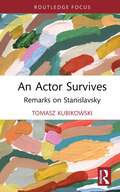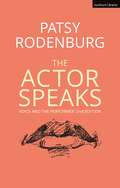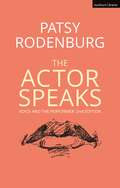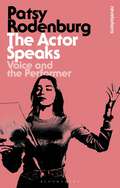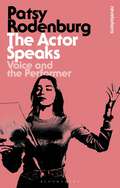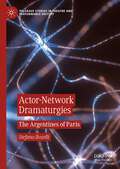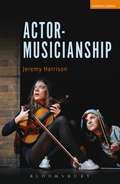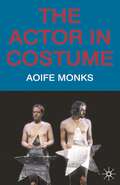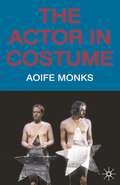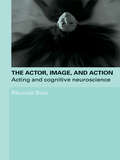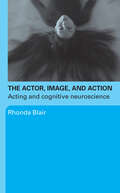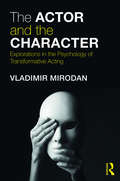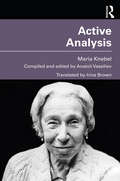- Table View
- List View
Actors and Performers Yearbook 2016: Essential Contacts for Stage, Screen and Radio
by Lloyd TrottActors and Performers Yearbook is an established and respected directory that enables actors to find work in stage, screen and radio. It is the only directory to provide detailed information for each listing and specific advice on how to approach companies and individuals, saving hours of further research. From agents and casting directors to producing theatres, showreel companies and photographers, Actors and Performers Yearbook editorially selects only the most relevant and reputable contacts for the actor.Actors and Performers Yearbook features articles and commentaries, providing valuable insight into the profession: auditions, interviews and securing work alongside a casting calendar and advice on contracts and finance. This is an incredibly useful professional tool in an industry where contacts and networking are key to career survival.The listings detailed in this edition have been thoroughly updated alongside fresh advice from industry experts.
Actors and Performers Yearbook 2016: Essential Contacts for Stage, Screen and Radio
by Lloyd TrottActors and Performers Yearbook is an established and respected directory that enables actors to find work in stage, screen and radio. It is the only directory to provide detailed information for each listing and specific advice on how to approach companies and individuals, saving hours of further research. From agents and casting directors to producing theatres, showreel companies and photographers, Actors and Performers Yearbook editorially selects only the most relevant and reputable contacts for the actor.Actors and Performers Yearbook features articles and commentaries, providing valuable insight into the profession: auditions, interviews and securing work alongside a casting calendar and advice on contracts and finance. This is an incredibly useful professional tool in an industry where contacts and networking are key to career survival.The listings detailed in this edition have been thoroughly updated alongside fresh advice from industry experts.
Actors and Performers Yearbook 2015
by Lloyd TrottActors and Performers Yearbook is an established and respected directory that enables actors to find work in stage, screen and radio. It is the only directory to provide detailed information for each listing and specific advice on how to approach companies and individuals, saving hours of further research. From agents and casting directors to producing theatres, showreel companies and photographers, Actors and Performers Yearbook editorially selects only the most relevant and reputable contacts for the actor.Formerly known as Actors' Yearbook, Actors and Performers Yearbook features articles and commentaries, providing valuable insight into the profession: auditions, interviews and securing work alongside a casting calendar and advice on contracts and finance. This is an incredibly useful professional tool in an industry where contacts and networking are key to career survival.The listings detailed in this edition have been thoroughly updated alongside fresh advice from industry experts.
Actors and Performers Yearbook 2015
by Lloyd TrottActors and Performers Yearbook is an established and respected directory that enables actors to find work in stage, screen and radio. It is the only directory to provide detailed information for each listing and specific advice on how to approach companies and individuals, saving hours of further research. From agents and casting directors to producing theatres, showreel companies and photographers, Actors and Performers Yearbook editorially selects only the most relevant and reputable contacts for the actor.Formerly known as Actors' Yearbook, Actors and Performers Yearbook features articles and commentaries, providing valuable insight into the profession: auditions, interviews and securing work alongside a casting calendar and advice on contracts and finance. This is an incredibly useful professional tool in an industry where contacts and networking are key to career survival.The listings detailed in this edition have been thoroughly updated alongside fresh advice from industry experts.
Actors and Audiences: Conversations in the Electric Air
by Caroline HeimActors and Audiences explores the exchanges between those on and off the stage that fill the atmosphere with energy and vitality. Caroline Heim utilises the concept of "electric air" to describe this phenomenon and discuss the charge of emotional electricity that heightens the audience’s senses in the theatre. In order to understand this electric air, Heim draws from in-depth interviews with 79 professional audience members and 22 international stage and screen actors in the United Kingdom, United States, France and Germany. Tapping into the growing interest in empirical studies of the audience, this book documents experiences from three productions – The Encounter, Heisenberg and Hunger. Peer Gynt – to describe the nature of these conversations. The interviews disclose essential elements: transference, identification, projection, double consciousness, presence, stage fright and the suspension of disbelief. Ultimately Heim reveals that the heart of theatre is the relationship between those on- and off-stage, the way in which emotions and words create psychological conversations that pass through the fourth wall into an "in-between space," and the resulting electric air. A fascinating introduction to a unique subject, this book provides a close examination of actor and audience perspectives, which is essential reading for students and academics of Theatre, Performance and Audience Studies.
Actors and Audiences: Conversations in the Electric Air
by Caroline HeimActors and Audiences explores the exchanges between those on and off the stage that fill the atmosphere with energy and vitality. Caroline Heim utilises the concept of "electric air" to describe this phenomenon and discuss the charge of emotional electricity that heightens the audience’s senses in the theatre. In order to understand this electric air, Heim draws from in-depth interviews with 79 professional audience members and 22 international stage and screen actors in the United Kingdom, United States, France and Germany. Tapping into the growing interest in empirical studies of the audience, this book documents experiences from three productions – The Encounter, Heisenberg and Hunger. Peer Gynt – to describe the nature of these conversations. The interviews disclose essential elements: transference, identification, projection, double consciousness, presence, stage fright and the suspension of disbelief. Ultimately Heim reveals that the heart of theatre is the relationship between those on- and off-stage, the way in which emotions and words create psychological conversations that pass through the fourth wall into an "in-between space," and the resulting electric air. A fascinating introduction to a unique subject, this book provides a close examination of actor and audience perspectives, which is essential reading for students and academics of Theatre, Performance and Audience Studies.
Actor Training
by Alison HodgeActor Training expands on Alison Hodge’s highly-acclaimed and best-selling Twentieth Century Actor Training. This exciting second edition radically updates the original book making it even more valuable for any student of the history and practice of actor training. The bibliography is brought right up to date and many chapters are revised. In addition, eight more practitioners are included - and forty more photographs - to create a stunningly comprehensive study. The practitioners included are: Stella Adler; Eugenio Barba; Augusto Boal; Anne Bogart; Bertolt Brecht; Peter Brook; Michael Chekhov; Joseph Chaikin; Jacques Copeau; Philippe Gaulier; Jerzy Grotowski; Maria Knebel; Jacques Lecoq; Joan Littlewood; Sanford Meisner; Vsevolod Meyerhold; Ariane Mnouchkine; Monika Pagneux; Michel Saint-Denis; W?odzimierz Staniewski; Konstantin Stanislavsky; Lee Strasberg The historical, cultural and political context of each practitioner’s work is clearly set out by leading experts and accompanied by an incisive and enlightening analysis of the main principles of their training, practical exercises and key productions. This book is an invaluable introduction to the principles and practice of actor training and its role in shaping modern theatre.
Actor Training
by Alison HodgeActor Training expands on Alison Hodge’s highly-acclaimed and best-selling Twentieth Century Actor Training. This exciting second edition radically updates the original book making it even more valuable for any student of the history and practice of actor training. The bibliography is brought right up to date and many chapters are revised. In addition, eight more practitioners are included - and forty more photographs - to create a stunningly comprehensive study. The practitioners included are: Stella Adler; Eugenio Barba; Augusto Boal; Anne Bogart; Bertolt Brecht; Peter Brook; Michael Chekhov; Joseph Chaikin; Jacques Copeau; Philippe Gaulier; Jerzy Grotowski; Maria Knebel; Jacques Lecoq; Joan Littlewood; Sanford Meisner; Vsevolod Meyerhold; Ariane Mnouchkine; Monika Pagneux; Michel Saint-Denis; W?odzimierz Staniewski; Konstantin Stanislavsky; Lee Strasberg The historical, cultural and political context of each practitioner’s work is clearly set out by leading experts and accompanied by an incisive and enlightening analysis of the main principles of their training, practical exercises and key productions. This book is an invaluable introduction to the principles and practice of actor training and its role in shaping modern theatre.
An Actor Survives: Remarks on Stanislavsky (Routledge Advances in Theatre & Performance Studies)
by Tomasz KubikowskiThis book focuses on the analysis and interpretation of the first volume of the book An Actor’s Work by Konstantin Stanislavsky. This volume is the only part of his planned major work on theatre art that he was able to finish and authorise before his death. Its highly edited variant has long been known as ‘An Actor Prepares’ in the English-speaking world. Tomasz Kubikowski explores Stanislavsky’s material not only as a handbook of acting but also as a philosophical testament of Stanislavsky, in which he attempts to contain his most essential experiences and reflections. This book explores the underlying theme of ‘survival’ in its various meanings, from professional to existential; and the mechanisms and actions we attempt to survive. This study will be of great interest to students and scholars in theatre and performance studies.
An Actor Survives: Remarks on Stanislavsky (Routledge Advances in Theatre & Performance Studies)
by Tomasz KubikowskiThis book focuses on the analysis and interpretation of the first volume of the book An Actor’s Work by Konstantin Stanislavsky. This volume is the only part of his planned major work on theatre art that he was able to finish and authorise before his death. Its highly edited variant has long been known as ‘An Actor Prepares’ in the English-speaking world. Tomasz Kubikowski explores Stanislavsky’s material not only as a handbook of acting but also as a philosophical testament of Stanislavsky, in which he attempts to contain his most essential experiences and reflections. This book explores the underlying theme of ‘survival’ in its various meanings, from professional to existential; and the mechanisms and actions we attempt to survive. This study will be of great interest to students and scholars in theatre and performance studies.
The Actor Speaks: Voice and the Performer (Performance Books)
by Patsy RodenburgFrom the bestselling author of The Right to Speak and The Need for Words comes this revised edition of the essential guide to voice work: The Actor Speaks. Beginning with what every first-year acting student faces in class and ending with what leading professional actors must achieve every night on stage, Patsy Rodenburg's celebrated work as one of the world's foremost voice and acting coaches is fully revealed in this thoughtful and inspirational book about acting.Written for the training and working actor, Rodenburg's book brings to life a wide range of exercises and methods to release the actor's voice, allowing the reader to perform every night, reaching the pitch, passion and vocal intensity that the best roles require.Revisited and revised for this new edition, The Actor Speaks is the ultimate voice book for actors.
The Actor Speaks: Voice and the Performer (Performance Books)
by Patsy RodenburgFrom the bestselling author of The Right to Speak and The Need for Words comes this revised edition of the essential guide to voice work: The Actor Speaks. Beginning with what every first-year acting student faces in class and ending with what leading professional actors must achieve every night on stage, Patsy Rodenburg's celebrated work as one of the world's foremost voice and acting coaches is fully revealed in this thoughtful and inspirational book about acting.Written for the training and working actor, Rodenburg's book brings to life a wide range of exercises and methods to release the actor's voice, allowing the reader to perform every night, reaching the pitch, passion and vocal intensity that the best roles require.Revisited and revised for this new edition, The Actor Speaks is the ultimate voice book for actors.
The Actor Speaks: Voice and the Performer (Bloomsbury Revelations)
by Patsy RodenburgFrom the bestselling author of The Right to Speak and The Need for Words comes this Bloomsbury Revelations edition of the essential guide to voice work: The Actor Speaks. Beginning with what every first-year acting student faces in class and ending with what leading professional actors must achieve every night on stage, Patsy Rodenburg's celebrated work as one of the world's foremost voice and acting coaches is fully revealed in this thoughtful and inspirational book about acting.Written for the training and working actor, Rodenburg's book brings to life a wide range of exercises and methods to release the actor's voice, covering everything from posture, breath and the body, performing in specific spaces, previews and first performances, managing different length runs, using microphones and dealing with an ageing or sick voice. This book allows the reader to perform every night, reaching the pitch, passion and vocal intensity that the best roles require.
The Actor Speaks: Voice and the Performer (Bloomsbury Revelations)
by Patsy RodenburgFrom the bestselling author of The Right to Speak and The Need for Words comes this Bloomsbury Revelations edition of the essential guide to voice work: The Actor Speaks. Beginning with what every first-year acting student faces in class and ending with what leading professional actors must achieve every night on stage, Patsy Rodenburg's celebrated work as one of the world's foremost voice and acting coaches is fully revealed in this thoughtful and inspirational book about acting.Written for the training and working actor, Rodenburg's book brings to life a wide range of exercises and methods to release the actor's voice, covering everything from posture, breath and the body, performing in specific spaces, previews and first performances, managing different length runs, using microphones and dealing with an ageing or sick voice. This book allows the reader to perform every night, reaching the pitch, passion and vocal intensity that the best roles require.
Actor-Network Dramaturgies: The Argentines of Paris (Palgrave Studies in Theatre and Performance History)
by Stefano BoselliThis book provides key critical tools to significantly broaden the readers’ perception of theatre and performance history: in line with posthuman thought, each chapter engages Actor-Network Theory and similar theories to reveal a comprehensive range of human and non-human agents whose collaborations impact theatre productions but are often overlooked. The volume also greatly expands the information available in English on the networks created by several Argentine artists. Through a transnational, transatlantic perspective, case studies refer to the lives, theatre companies, staged productions, and visual artworks of a number of artists who left Buenos Aires during the 1960s due to a mix of personal and political reasons. By establishing themselves in the French capital, queer playwright Copi and directors Jorge Lavelli, Alfredo Arias, and Jérôme Savary, among others, became part of the larger group of intellectuals known as “the Argentines of Paris” and dominated the Parisian theatre scene between the 1980s and 90s. Focusing on these Argentine artists and their nomadic peripeteias, the study thus offers a detailed description of the complexity of agencies and assemblages inextricably involved in theatre productions, including larger historical events, everyday objects, sexual orientation, microbes, and even those agents at work well before a production is conceived.
Actor-Musicianship (Performance Books)
by Jeremy HarrisonActor-musicianship is a permanent feature of the musical theatre landscape. Actor-musician shows can be seen from Bradford to Broadway, from village halls to international arena tours. However, with the exception of a couple of academic papers, there has been nothing written about this fascinating area of theatre practice. Jeremy Harrison's book addresses this deficit, operating as both a record of the development of the actor-musician movement and as a practical guide for students, educators, performers and practitioners. It explores the history of actor-musicianship, examining its origins, as well as investigating – and offering guidance on – how this specialist form of music theatre is created. It, in turn, acts as a means of defining an art form that has to date been left to lurk in the shadows of musical theatre; a subset with its own distinctive culture of performer, maker and audience, but as yet no formal recognition as a specialism in its own right. The actor-musician show is multifarious and as such this book targets those interested in mainstream commercial work, as well as alternative and avant-garde theatre practice. The book draws together expertise from a range of disciplines with contributions from many of the leading figures in this field, including performers, directors, teachers, MDs, producers and writers. It also features a foreword by theatre director John Doyle.
Actor-Musicianship (Performance Books)
by Jeremy HarrisonActor-musicianship is a permanent feature of the musical theatre landscape. Actor-musician shows can be seen from Bradford to Broadway, from village halls to international arena tours. However, with the exception of a couple of academic papers, there has been nothing written about this fascinating area of theatre practice. Jeremy Harrison's book addresses this deficit, operating as both a record of the development of the actor-musician movement and as a practical guide for students, educators, performers and practitioners. It explores the history of actor-musicianship, examining its origins, as well as investigating – and offering guidance on – how this specialist form of music theatre is created. It, in turn, acts as a means of defining an art form that has to date been left to lurk in the shadows of musical theatre; a subset with its own distinctive culture of performer, maker and audience, but as yet no formal recognition as a specialism in its own right. The actor-musician show is multifarious and as such this book targets those interested in mainstream commercial work, as well as alternative and avant-garde theatre practice. The book draws together expertise from a range of disciplines with contributions from many of the leading figures in this field, including performers, directors, teachers, MDs, producers and writers. It also features a foreword by theatre director John Doyle.
The Actor in Costume
by Aoife MonksHow do audiences look at actors in costume onstage? How does costume shape theatrical identity and form bodies? What do audiences wear to the theatre? This lively and cutting-edge book explores these questions, and engages with the various theoretical approaches to the study of actors in performance. Aoife Monks focuses in particular on the uncanny ways in which costume and the actor's body are indistinguishable in the audience's experience of a performance. From the role of costume in Modernist theatre to the actor's position in the fashion system, from nudity to stage ghosts, this wide-ranging exploration of costume, and its histories, argues for the centrality of costume to the spectator's experience at the theatre. Drawing on examples from paintings, photographs, live performances, novels, reviews, blogs and plays, Monks presents a vibrant analysis of the very peculiar work that actors and costumes do on the stage.
The Actor in Costume
by Aoife MonksHow do audiences look at actors in costume onstage? How does costume shape theatrical identity and form bodies? What do audiences wear to the theatre? This lively and cutting-edge book explores these questions, and engages with the various theoretical approaches to the study of actors in performance. Aoife Monks focuses in particular on the uncanny ways in which costume and the actor's body are indistinguishable in the audience's experience of a performance. From the role of costume in Modernist theatre to the actor's position in the fashion system, from nudity to stage ghosts, this wide-ranging exploration of costume, and its histories, argues for the centrality of costume to the spectator's experience at the theatre. Drawing on examples from paintings, photographs, live performances, novels, reviews, blogs and plays, Monks presents a vibrant analysis of the very peculiar work that actors and costumes do on the stage.
The Actor, Image, and Action: Acting and Cognitive Neuroscience
by Rhonda BlairThe Actor, Image and Action is a 'new generation' approach to the craft of acting; the first full-length study of actor training using the insights of cognitive neuroscience. In a brilliant reassessment of both the practice and theory of acting, Rhonda Blair examines the physiological relationship between bodily action and emotional experience. In doing so she provides the latest step in Stanislavsky's attempts to help the actor 'reach the unconscious by conscious means'. Recent developments in scientific thinking about the connections between biology and cognition require new ways of understanding many elements of human activity, including: imagination emotion memory physicality reason. The Actor, Image and Action looks at how these are in fact inseparable in the brain's structure and function, and their crucial importance to an actor’s engagement with a role. The book vastly improves our understanding of the actor's process and is a must for any actor or student of acting.
The Actor, Image, and Action: Acting and Cognitive Neuroscience
by Rhonda BlairThe Actor, Image and Action is a 'new generation' approach to the craft of acting; the first full-length study of actor training using the insights of cognitive neuroscience. In a brilliant reassessment of both the practice and theory of acting, Rhonda Blair examines the physiological relationship between bodily action and emotional experience. In doing so she provides the latest step in Stanislavsky's attempts to help the actor 'reach the unconscious by conscious means'. Recent developments in scientific thinking about the connections between biology and cognition require new ways of understanding many elements of human activity, including: imagination emotion memory physicality reason. The Actor, Image and Action looks at how these are in fact inseparable in the brain's structure and function, and their crucial importance to an actor’s engagement with a role. The book vastly improves our understanding of the actor's process and is a must for any actor or student of acting.
The Actor and the Character: Explorations in the Psychology of Transformative Acting
by Vladimir MirodanTransformative acting remains the aspiration of many an emerging actor, and constitutes the achievement of some of the most acclaimed performances of our age: Daniel Day-Lewis as Lincoln, Meryl Streep as Mrs Thatcher, Anthony Hopkins as Hannibal Lecter – the list is extensive, and we all have our favourites. But what are the physical and psychological processes which enable actors to create characters so different from themselves? To understand this unique phenomenon, Vladimir Mirodan provides both a historical overview of the evolution of notions of 'character' in Western theatre and a stunning contemporary analysis of the theoretical implications of transformative acting. The Actor and the Character: Surveys the main debates surrounding the concept of dramatic character and – contrary to recent trends – explains why transformative actors conceive their characters as ‘independent’ of their own personalities. Describes some important techniques used by actors to construct their characters by physical means: work on objects, neutral and character masks, Laban movement analysis, Viewpoints, etc. Examines the psychology behind transformative acting from the perspectives of both psychoanalysis and scientific psychology and, based on recent developments in psychology, asks whether transformation is not just acting folklore but may actually entail temporary changes to the brain structures of the actors. The Actor and the Character speaks not only to academics and students studying actor training and acting theory, but contributes to current lively academic debates around character. This is a compelling and original exploration of the limits of acting theory and practice, psychology, and creative work, in which Mirodan boldly re-examines some of the fundamental assumptions of actor training and some basic tenets of theatre practice to ask: What happens when one of us ‘becomes somebody else’?
The Actor and the Character: Explorations in the Psychology of Transformative Acting
by Vladimir MirodanTransformative acting remains the aspiration of many an emerging actor, and constitutes the achievement of some of the most acclaimed performances of our age: Daniel Day-Lewis as Lincoln, Meryl Streep as Mrs Thatcher, Anthony Hopkins as Hannibal Lecter – the list is extensive, and we all have our favourites. But what are the physical and psychological processes which enable actors to create characters so different from themselves? To understand this unique phenomenon, Vladimir Mirodan provides both a historical overview of the evolution of notions of 'character' in Western theatre and a stunning contemporary analysis of the theoretical implications of transformative acting. The Actor and the Character: Surveys the main debates surrounding the concept of dramatic character and – contrary to recent trends – explains why transformative actors conceive their characters as ‘independent’ of their own personalities. Describes some important techniques used by actors to construct their characters by physical means: work on objects, neutral and character masks, Laban movement analysis, Viewpoints, etc. Examines the psychology behind transformative acting from the perspectives of both psychoanalysis and scientific psychology and, based on recent developments in psychology, asks whether transformation is not just acting folklore but may actually entail temporary changes to the brain structures of the actors. The Actor and the Character speaks not only to academics and students studying actor training and acting theory, but contributes to current lively academic debates around character. This is a compelling and original exploration of the limits of acting theory and practice, psychology, and creative work, in which Mirodan boldly re-examines some of the fundamental assumptions of actor training and some basic tenets of theatre practice to ask: What happens when one of us ‘becomes somebody else’?
Active Analysis
by Maria KnebelActive Analysis combines two of Maria Knebel’s most important books, On Active Analysis of the Play and the Role and The Word in the Actor’s Creative Work, in a single edition conceived and edited by one of Knebel's most famous students, the renowned theatre and film director, Anatoli Vassiliev. This is the first English translation of an important and authoritative fragment of the great Stanislavski jigsaw. A landmark publication. This book is an indispensable resource for professional directors, student directors, actors and researchers interested in Stanislavski, directing, rehearsal methods and theatre studies more generally.
Active Analysis
by Maria KnebelActive Analysis combines two of Maria Knebel’s most important books, On Active Analysis of the Play and the Role and The Word in the Actor’s Creative Work, in a single edition conceived and edited by one of Knebel's most famous students, the renowned theatre and film director, Anatoli Vassiliev. This is the first English translation of an important and authoritative fragment of the great Stanislavski jigsaw. A landmark publication. This book is an indispensable resource for professional directors, student directors, actors and researchers interested in Stanislavski, directing, rehearsal methods and theatre studies more generally.
